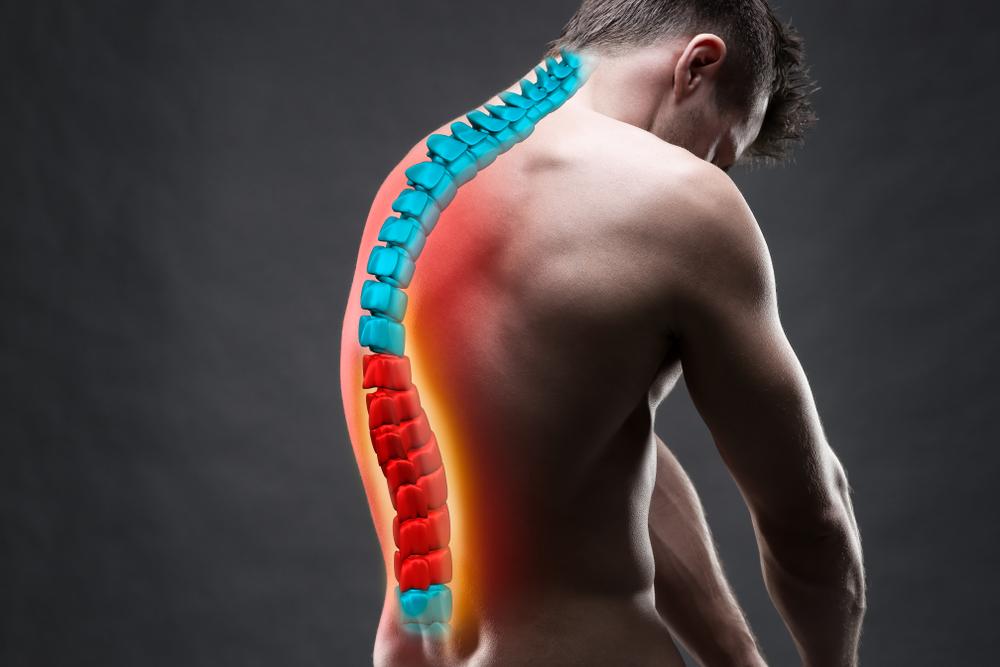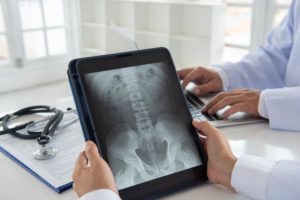Herniated Disc Chiropractor
 You may think of your spine as being made of bone, but it is actually a structure made up of a variety of tissues that work together to keep you upright and flexible. Intervertebral discs, which sit between the bones of the spine, are an important part of that structure, and when one is damaged or knocked out of place, it can cause severe pain and other symptoms. While a ruptured or herniated disc is a serious condition, most cases can be effectively addressed by a Snellville chiropractor.
You may think of your spine as being made of bone, but it is actually a structure made up of a variety of tissues that work together to keep you upright and flexible. Intervertebral discs, which sit between the bones of the spine, are an important part of that structure, and when one is damaged or knocked out of place, it can cause severe pain and other symptoms. While a ruptured or herniated disc is a serious condition, most cases can be effectively addressed by a Snellville chiropractor.
What Is a Herniated Disc?
Between each vertebra in the spine (besides C1 and C2), there sits a small disc that acts as a shock absorber and distributor. These discs prevent the bone from rubbing together during movement, allowing your spine to be more flexible and able to twist and turn in a variety of directions. While the discs have a hard outer layer (the annulus) that offers support, the inner nucleus is a gel-like substance that provides the movement needed for the spine to function properly.
These discs can be damaged in a variety of ways, typically involving some portion of the nucleus protruding from the other layer and entering the spinal canal. While this can be called a bulged, slipped, or ruptured disc, a herniated disc is the more common term for any one of these injuries. The pain of a herniated disc doesn’t come from the damage to the disc itself but because the disc enters the spinal canal and impedes the space normally reserved for the spinal nerves. The disc then places pressure on these nerves, causing pain and other symptoms.
A herniated disc can occur in any part of the spine, though they are more common in the lower back.
Causes of Disc Herniation
As we age, it is very common for our discs to experience degeneration. This can be due to issues like dehydration but is often linked to the weakening of ligaments that hold the discs in place. When discs are in this weakened state, they can become herniated in response to very little stimuli- a simple bending or twisting motion can be enough to cause the condition. Even without a triggering event, discs that have lost enough water content can shrink enough that the vertebrae are no longer supported properly and the discs become painful.
Discs can also be damaged in response to a traumatic event like a fall or a car accident where the force is enough to cause movement and rupture. This may be more severe if someone already has disc degeneration but can occur in someone with completely healthy discs as well.
Most people cannot pinpoint the moment when their disc ruptured unless there is a specific event like this.
Certain factors will increase your risk for disc herniation, such as:
- A sedentary lifestyle can contribute by preventing your spine from being accustomed to movement and remaining healthy.
- Frequent driving, or riding in a vehicle, combines sitting for long periods and a vibration from car engines that puts additional pressure on the spine.
- Smoking reduces oxygen supply to discs, contributing to faster degeneration.
- Genetic predisposition can make someone with a family history of disc herniation more prone to the condition.
- Certain occupations increase the risk of back problems when they involve repetitive lifting, pushing, pulling, bending, and twisting.
- Excess weight can put extra stress on the discs in the lower back.
In addition to older people being more likely to suffer from a herniated disc, men are also more commonly diagnosed with the condition.
 Signs You Have a Herniated Disc
Signs You Have a Herniated Disc
The symptoms of a herniated disc may vary based on where the disc sits in your spine and what nerves it may be compressing. Some people do not experience any symptoms at all, but most will have at least one. In most cases, these symptoms will be isolated to one side of the body.
Common symptoms of a herniated disc can include:
- Arm or leg pain. The nerves affected by a disc herniation are often tied to your extremities. A herniated disc in the lower back can cause pain near the disc, but it may also extend down your buttocks, thighs, calves, and even feet. If the herniation is in your neck or cervical spine, the pain will typically be felt in your shoulder and arm. You may also feel the pain shoot down your arm and leg during a sudden movement such as a cough or sneeze. The pain is often described as sharp or burning by patients.
- Numbness and tingling. When the disc pinches or compresses a nerve, it can impact the body parts affected by that nerve and cause a temporary loss of feeling or tingling. This is similar to the feeling when your foot or hand “falls asleep” after being in one position for too long but may be prolonged or even constant.
- Weakness. The muscles served by affected nerves can weaken. This may cause you to stumble or have trouble lifting your arms and holding onto items.
- Loss of bladder or bowel control. In severe cases, you can lose the ability to control systems in your body, such as your bladder or bowel movements.
Herniated discs do not typically resolve on their own. Even if your symptoms seem to have gone away, you should seek professional care to prevent them from returning in the future.
 Diagnosing a Herniated Disc
Diagnosing a Herniated Disc
Herniated discs are one of the conditions most often treated by chiropractors. When you present with symptoms of a herniated disc, a skilled Snellville chiropractor will be able to perform a series of assessments to quickly determine if that is what is causing your pain. They will begin by asking about your symptoms and medical history, as well as performing a physical examination.
Chiropractors may use certain tests during the course of an examination. Two common tests are:
- A neurological examination to identify any weakness or loss of sensation. They may assess how you walk on your heels and toes, whether you can feel light touches, and how strong your reflexes are.
- The straight leg raise (SLR) test. This is a specialized test that is especially effective in young patients to identify a herniated disc. You will lie on your back while the chiropractor lifts your impacted leg with your knee remaining straight. If you have pain below the knee, it is an indication of a herniated disc.
If the chiropractor wants to rule out other injuries or pinpoint the problematic disc, they may also use diagnostic imaging like an MRI or CT scan to get clear images of the spine. This can also be important as a chiropractor wants to understand the health and mechanics of your entire spine, not just the area that is causing pain, to ensure any misalignments are addressed.
Chiropractic Care for Herniated Discs
Once they understand what discs are affected and how your spine is responding, a chiropractor can create a personalized care plan to help repair the issue. Chiropractors focus on addressing the root cause of your symptoms, so the goal will be to relieve the conditions that caused the herniation and to allow the disc to return to its normal positioning.
The primary modality used by chiropractors is spinal adjustment, in which they use their hands and specialized tools to manipulate the spine to help it return to alignment. The most common form of adjustment for herniated discs is the flexion-distraction technique. This technique uses a specialized table meant to “distract” or stretch the spine, allowing the chiropractor to isolate the impacted area. A pumping motion is then used to flex the spine.
Flexion-distraction can not only help the disc return to its proper position, but it may improve disc height as well. As the disc is removed from the nerve, inflammation will slowly go down and pain will resolve.
Adjustments are typically painless, with some soreness being the worst of the associated side effects. You will typically need to undergo a series of adjustments to ensure the spine has returned to alignment and remains there in the future.
Chiropractors may also use a technique known as pelvic blocking, in which cushioned wedges are placed under your pelvis, allowing your herniated disc to shift away from the nerves.
 Additional Treatment Options
Additional Treatment Options
Along with chiropractic adjustments, there are some steps you can take at home to help relieve the symptoms of a herniated disc and encourage healing. You may also be advised to use other forms of treatment alongside chiropractic care for the best results, and in severe cases, invasive options like surgery may be necessary. A chiropractor will also work with you to create a plan for the prevention of future herniation.
Home Remedies
If you begin to notice signs of a herniated disc, the best thing you can do is to immediately rest for a short period of time. One to two days of bed rest will usually relieve symptoms, along with stopping any activities that worsen the pain. It is best to reintroduce slow and low-impact activity rather than staying inactive for a long period, being sure to monitor for further pain and not to push your limits.
Using ice packs can help relieve pain and inflammation in the days after an injury has occurred, and heat packs can later help with muscle tightness or spasms. You can also use nonsteroidal anti-inflammatory drugs (NSAIDs) such as ibuprofen to manage pain. Some people also find massage a helpful tool for managing symptoms.
Other Therapies
Alongside chiropractic care, it may be recommended that you work with a physical therapist to develop a specific course of exercises. These can help you regain flexibility and range of motion in the spine, as well as work to strengthen your spine so that herniation does not recur down the line.
If you are struggling with pain that prevents you from movement, like physical therapy, epidural steroid injections can be helpful. These injections place a cortisone-like medication into the space around a nerve, providing short-term pain relief and targeting inflammation.
Surgical Treatment
A small portion of patients with a herniated disc will require surgery to resolve the issue. This is typically recommended only when other treatment options have not offered relief or when a patient is experiencing severe symptoms like trouble walking and a loss of bladder or bowel control.
The most common procedure is a microdiscectomy, in which a small incision and microscope are used to remove the herniated portion of the disc and any additional fragments that may be present. In more severe cases, the entire disc may need to be removed. When this happens, it can either be replaced by an artificial disc or the surrounding vertebrae can be fused together to prevent movement.
Future Prevention
Having a herniated disc is itself considered a risk factor for future herniation, in the same spot or a different one. Chiropractors do not just fix the issue at hand but are usually focused on creating an overall pattern of health and determining ways to prevent recurrence through a stronger spine.
Your chiropractor may offer tips on maintaining a good posture and using proper form when doing things like lifting heavy objects, as well as suggesting exercises that can help stabilize and support the spine in the long term. Chiropractors are also able to offer lifestyle suggestions, like how to maintain a healthy weight to avoid extra pressure and that quitting smoking can have many benefits.
When you work with the expert chiropractors at AICA Snellville, you are able to benefit from their experience. Each patient receives a comprehensive care plan designed to meet their exact needs and goals. In addition to your chiropractor, AICA Snellville has a full team of experts, from physical therapists to radiologists to surgeons, who can work together to ensure your herniated disc is treated effectively and with your specific case in mind. To begin working with us, reach out today to schedule your first consultation and begin working towards a healthier spine.

 Signs You Have a Herniated Disc
Signs You Have a Herniated Disc Diagnosing a Herniated Disc
Diagnosing a Herniated Disc Additional Treatment Options
Additional Treatment Options